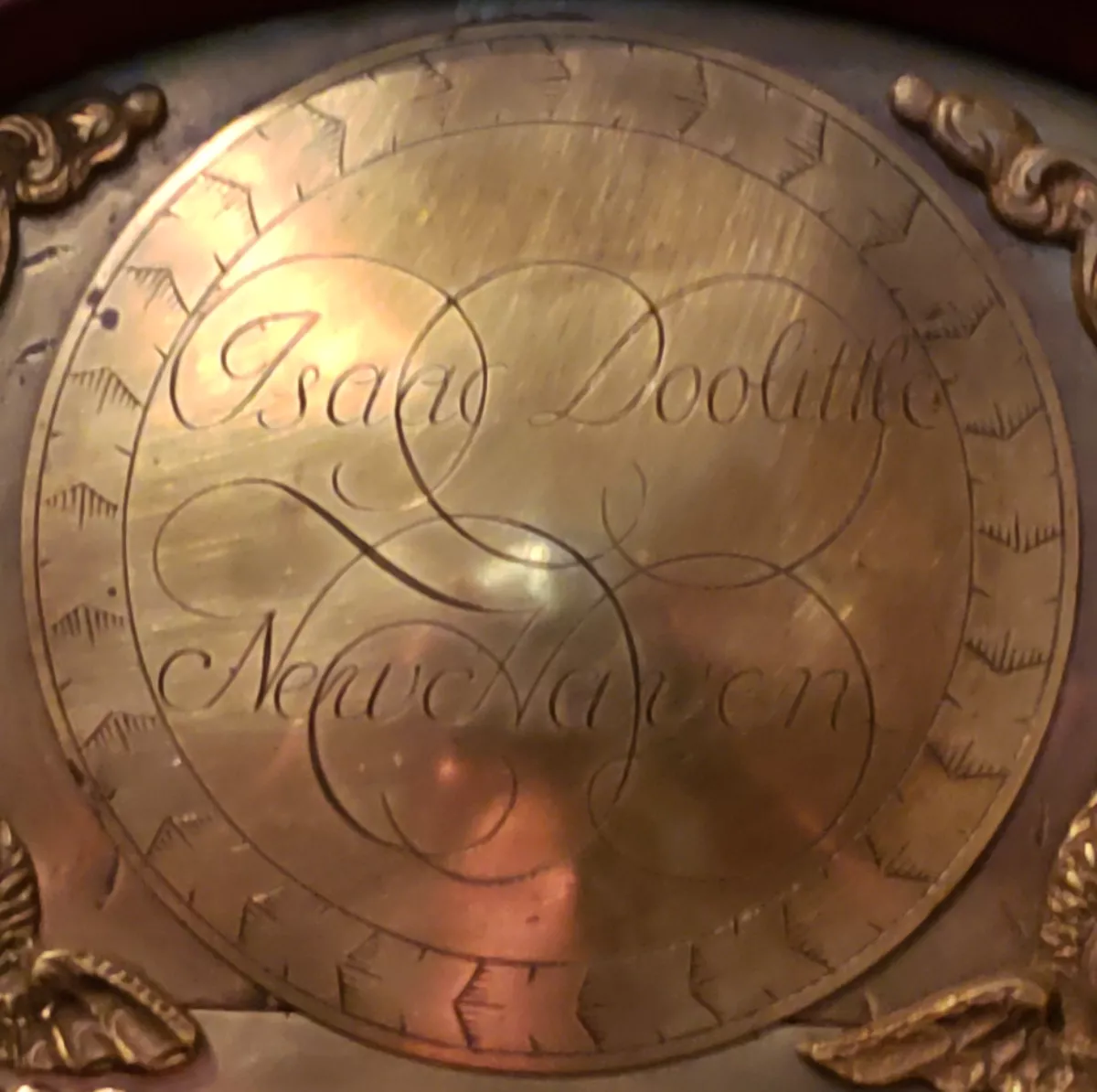 1.
1. Isaac Doolittle was an early American clockmaker, inventor, engineer, manufacturer, militia officer, entrepreneur, printer, politician, and brass, iron, and silver artisan.

 1.
1. Isaac Doolittle was an early American clockmaker, inventor, engineer, manufacturer, militia officer, entrepreneur, printer, politician, and brass, iron, and silver artisan.
Isaac Doolittle was an engraver and printer of both legal forms and currency, and became the first American to design, manufacture, and sell a printing press in 1769.
Isaac Doolittle was an important figure in the religious life of Connecticut as an Episcopal Churchwarden and co-founder of Trinity Church on the Green in New Haven.
In making the watch work triggering mechanism for Bushnell's explosive underwater magazine, Isaac Doolittle created the first mechanical time bomb, while his two-blade propeller was the first practical and applied use of a propeller in watercraft.
Isaac Doolittle was well known in his time as an "ingenious mechanic", or what would be called an engineer today.
Isaac Doolittle's many pioneering innovations are associated with the popular notion of Yankee ingenuity, for which he has been called "The First Yankee".
Isaac Doolittle was born in Wallingford, Connecticut, the son of Joseph and Elizabeth Doolittle.
Isaac Doolittle opened a shop across from Yale College on Chapel Street, where he repaired, made, and sold not only clocks and watches, but "compasses, sea and land surveyors scales and protractors, gauging rods, walking sticks, silver plated buttons turned upon a horn, and a variety of other work".
Isaac Doolittle continued on in the role of warden, guiding the parish for much of the next 35 years, from 1750 to 1765, from 1770 to 1777, and again from 1783 to 1785.
Isaac Doolittle was again appointed Armorer in 1758, this time for Connecticut's Fourth Regiment under Colonel David Wooster.
Isaac Doolittle designed an innovative nested bateau or lake boat for the 1755 amphibious attack on Fort Carillion and saw the construction of the Land Tortoise, a floating gunboat, skills he would use two decades later in the American Revolution.
Isaac Doolittle gained firsthand knowledge of British leadership incompetence in the disastrous expedition against Fort Carillon as well as their superior naval capabilities in the successful Siege of Louisbourg of 1758.
Isaac Doolittle was selling imported silver watches, and advertising his own manufactured clocks, bar iron, "screws for clothiers" and surveyor's instruments and mariner's compasses in his Chapel Street shop.
Isaac Doolittle was a sealer of weights and measures for town of New Haven, and printed Connecticut currency in his shop as well as government forms.
Isaac Doolittle would continue to cast bells almost until his death in 1800.
Isaac Doolittle was a member of the New Haven Committee of Correspondence.
Isaac Doolittle was a New Haven selectman and served on a committee to procure guns for the town's defense.
Isaac Doolittle was appointed that year to a Connecticut government committee to prospect for lead mines in the colony.
However, only two of the 100 heads of households of the church Isaac Doolittle helped found were Loyalists.
Isaac Doolittle was a very wealthy and highly respected 55 year old head of a family of seven, a successful shop owner with a thriving business, the long time Warden and founder of Trinity Church in New Haven, and a pillar of the city, where he was a city and state armorer, tax collector, selectman, port inspector, lead prospector, and gunpowder miller with access to government funding.
Isaac Doolittle was experienced in large metal design and manufacturing of iron screws and brass bells, as well as the more delicate design and construction of pumps, navigation instruments, and clockwork devices.
Isaac Doolittle owned with his own foundry and had team of apprentices at hand, many of whom were underemployed as "the demand for clocks was extremely limited" darning the war.
Isaac Doolittle had access to gunpowder and lead, the two most scarce materials needed for the submarine.
Isaac Doolittle's propeller, described as a "a pair of oars fixed like the two opposite arms of a windmill", had "no precedent" in design and was the first known use of a bladed propeller in a watercraft.
Sarah Todd Isaac Doolittle was born on January 30,1725, in New Haven, and died on March 10,1814, in New Haven.
Isaac Doolittle continued to make clocks and cast bells until 1797, when his health failed again and he largely retired from business.
Isaac Doolittle died on February 13,1800, at age 78, according to his obituary, "after a long and distressing illness of several years", honored as "a very worthy and respectable character".
Isaac Doolittle's wife Sarah, born on January 30,1725, in New Haven, Connecticut, died on March 10,1814, in New Haven and is buried in Center Street Cemetery, Wallingford, Connecticut.
The brass works for a number of Isaac Doolittle's clocks survive in private hands, and a circa 1765 "tall clock" is part of the holding of the Metropolitan Museum of Art in New York City.
Doolittle's grandson, Isaac Doolittle III, was a Patriot in the War of 1812, an inventor who patented devices for steam engines and furnaces, and, like his grandfather, a pioneering printer and artist who illustrated the poem "Old Santeclaus with Much Delight" in an 1821 book that was the first publication to illustrate the modern American legend of Santa Claus.
Isaac Doolittle published it along with a glossary of peculiar Yankee's expressions and pronunciations that was mined for decades by other playwrights.
For over half a century, from 1743 until his retirement in 1797, Isaac Doolittle was "one of the leading manufacturers and most versatile mechanics" in the American colonies and "a citizen of character and enterprise, whose mark in his generation was that of striking originality", as well as a key historical transition figure in the shift from Puritan to Yankee in New England.